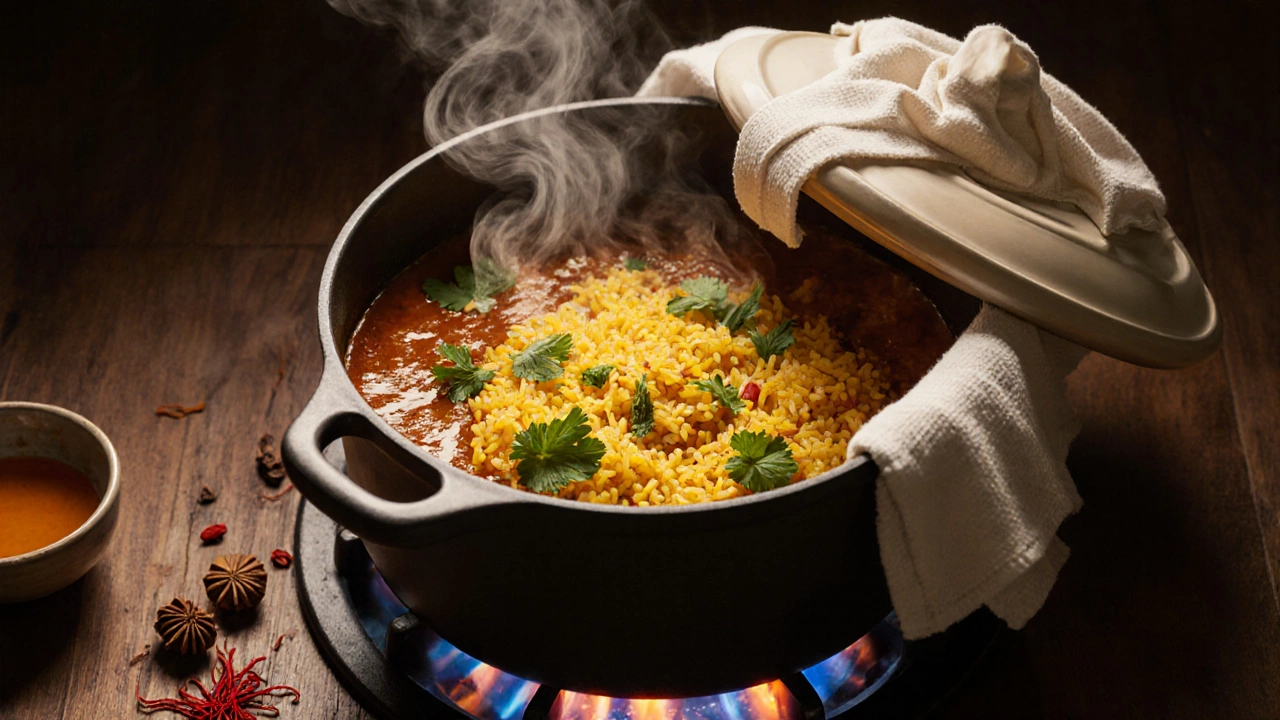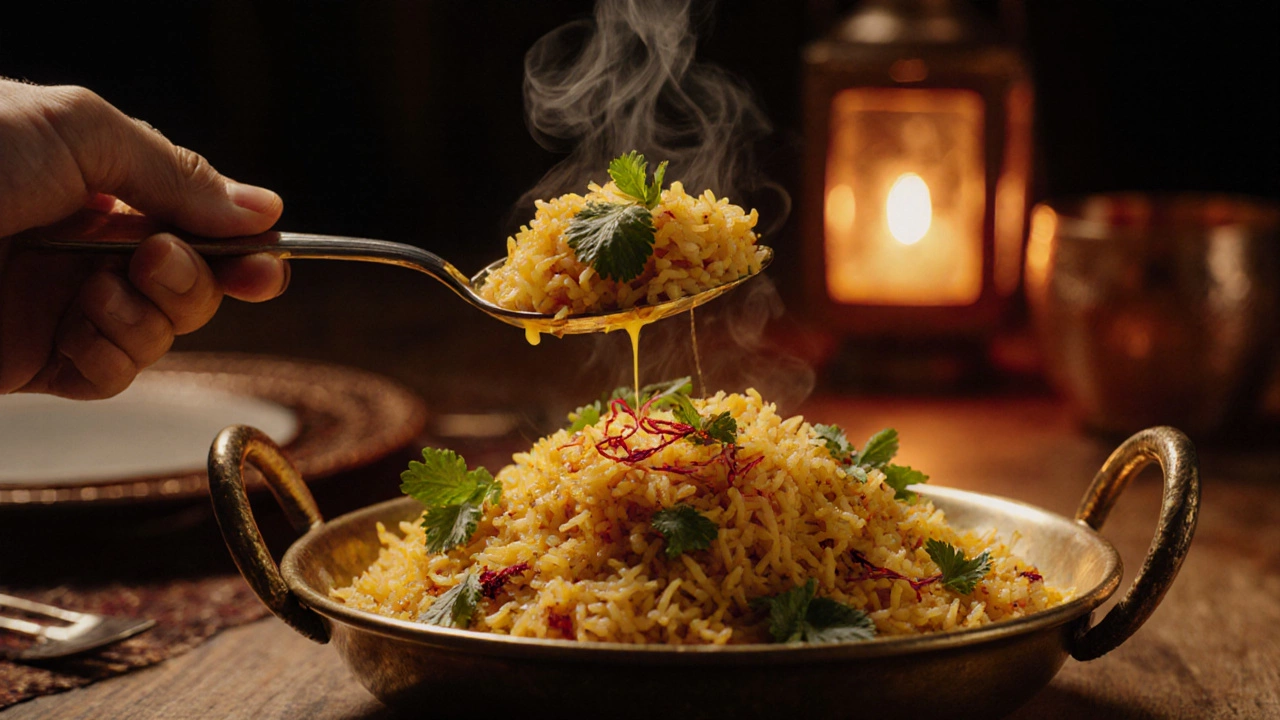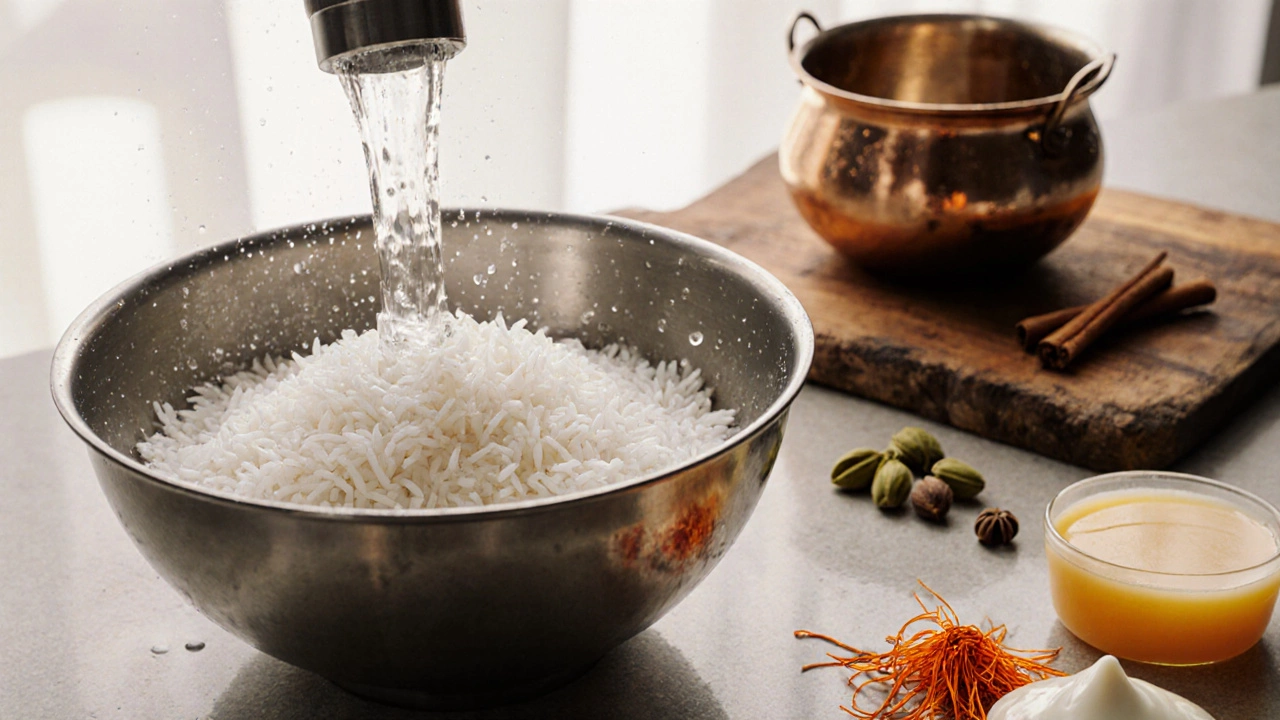Biryani Rice-to-Liquid Ratio Calculator
Biryani Moisture Calculator
Biryani is a layered rice dish that hails from the Indian subcontinent and is celebrated for its aromatic spices and melt‑in‑your‑mouth textures. When done right, every grain should be soft, each bite moist, and the whole pot brimming with flavor. The secret to that perfect mouthfeel? It’s all about controlling moisture, mastering the cooking method, and using the right supporting ingredients.
Key Takeaways
- Use long‑grain Basmati rice and rinse it thoroughly to remove excess starch.
- Employ a 1:1.5 rice‑to‑liquid ratio for par‑boiling and a 1:1 ratio for the final juicy biryani steam.
- Incorporate fat‑rich agents like Ghee and yogurt to lock in moisture.
- Seal the pot tightly for the "dum" (steam) phase; a heavy lid or dough seal prevents steam escape.
- Finish with a brief resting period so flavors marry and steam redistributes evenly.
The Science Behind Moist Rice
Moisture retention starts at the grain level. Basmati’s long fibers contain a hollow center that expands when heated. If you soak the rice for 30 minutes, the kernels absorb water, reducing the amount needed during cooking and preventing them from bursting open.
During the first boil, aim for a texture that’s just shy of al‑dente-about 70 % done. This gives the grain a sturdy shell that will absorb the remaining broth during the dum stage without turning mushy. Over‑cooking at this stage forces the starch to gelatinize too much, releasing excess liquid later and creating soggy layers.
Ingredients That Add Juiciness
Yogurt isn’t just for tenderizing meat; its slight acidity breaks down protein fibers in chicken, lamb, or vegetables, allowing them to release their own juices into the rice. A tablespoon of yogurt per cup of meat is a good rule of thumb.
Fat is a moisture‑locking agent. Ghee coats the rice grains, creating a barrier that slows water evaporation. Melt a few tablespoons with whole spices (cinnamon, cardamom, cloves) before adding the rice, and you’ll notice a richer aroma and a silkier mouthfeel.
Don’t overlook Saffron steeped in warm milk. The colored milk not only adds a golden hue but also contributes a thin layer of dairy fat, enhancing overall juiciness.
Lastly, use a well‑seasoned stock (chicken, vegetable, or beef) instead of plain water. The salt and collagen in stock help retain moisture and deepen flavor.

Cooking Techniques That Lock in Moisture
The classic "dum" method resembles a pressure‑cooker without the pressure. You layer partially cooked rice over a spiced meat mixture, seal the pot, and let it steam on low heat. The key is a tight seal-either a heavy‑bottomed lid wrapped with a kitchen cloth and dough, or a Dutch oven with its own lid.
| Method | Moisture Retention | Flavor Depth | Typical Time |
|---|---|---|---|
| Dum (sealed pot) | High - steam stays trapped | Very high - spices infuse slowly | 30‑45 min |
| Pressure cooker | Medium - pressure forces moisture in | High - quick flavor melding | 15‑20 min |
| Stovetop without seal | Low - steam escapes | Moderate - spices may burn | 40‑50 min |
Step‑by‑Step Checklist for a Moist Biryani
- Rinse and soak Basmati rice (30 min). Drain and set aside.
- Marinate your protein with yogurt, ginger‑garlic paste, turmeric, and a pinch of salt. Let sit for at least 45 min.
- Prepare the spice base: heat ghee, add whole spices (bay leaf, cinnamon, cloves, cardamom), then sauté onions until caramelized.
- Add chopped tomatoes, green chilies, and ground spices (coriander, cumin, garam masala). Cook until oil separates.
- Stir in the marinated protein and a splash of stock. Cook until the meat is ~70 % done.
- In a separate pot, bring stock to a boil, add a pinch of salt, and par‑boil the soaked rice for 5‑6 minutes (70 % cooked). Drain.
- Layer the pot: start with a thin layer of the meat gravy, then a layer of rice, sprinkle fried onions, fresh cilantro, mint, and a few strands of saffron‑milk.
- Repeat layers, ending with rice on top. Drizzle a teaspoon of ghee over the final layer.
- Seal the pot tightly with a lid wrapped in a clean kitchen cloth and dough (optional). Place a heavy pan or griddle on low flame beneath the pot to prevent direct heat.
- Cook on low for 25‑30 minutes (dum). Turn off the heat and let it rest, still sealed, for 10 minutes.
- Gently fluff with a wide spoon, mixing the layers just enough to keep grains whole.
Common Mistakes and How to Fix Them
- Too much water - If the rice turns mushy, the culprit is usually an excess liquid ratio. Next time, reduce the broth by 10 % and remember the 1:1.5 ratio for par‑boiling.
- Steam escaping - A loose lid causes dryness. Use a dough seal or a thick kitchen towel to create an airtight barrier.
- Over‑cooking the rice - Over‑softened grains release starch that makes the biryani clumpy. Stop cooking the rice when a tiny hard center remains.
- Insufficient fat - Skipping ghee or using low‑fat oil leads to dry texture. Ensure at least two tablespoons of ghee are mixed into the spice base.
- Skipping the rest period - Cutting straight to the plate releases trapped steam, leaving the top layer dry. Let the sealed pot sit for at least ten minutes before serving.

Pro Tips from Seasoned Chefs
1. Char the onions until deep brown, then blend a portion into a smooth paste. This adds a caramelized depth without burning the spices.
2. Use a waterfall of hot stock over the rice during layering. The sudden burst of heat seals the grains instantly.
3. Introduce a thin layer of rose water or kewra essence after the final steam. It adds an aromatic seal that tricks the nose into perceiving extra moisture.
4. Finish with a drizzle of clarified butter right before serving. The butter melts into the hot rice, enhancing gloss and juiciness.
Quick Troubleshooting Guide
- Dry, cracked rice? Add a splash of warm stock, cover, and let it steam for another 5 minutes.
- Too soggy? Spread the biryani on a large plate, let excess moisture evaporate for a few minutes, then gently fold back.
- Uneven spice distribution? Use a wide, flat spoon to lift and turn the biryani, preserving the grain integrity while mixing.
Frequently Asked Questions
Can I use regular rice instead of Basmati?
Regular short‑grain rice releases more starch, making it prone to clumping. You can still achieve a moist biryani, but the grains won’t stay separate; you’ll end up with a softer, almost porridge‑like texture.
Is it okay to skip the soaking step?
Skipping soaking shortens prep time, but the rice absorbs less water, so you’ll need a bit more stock to keep it juicy. Expect a slightly firmer bite.
Do I need a heavy‑bottomed pot for dum?
A thick pot distributes heat evenly and prevents the bottom layer from scorching, which can dry out the entire pot. If you only have a thin pan, use a diffuser and keep the flame very low.
Can I make biryani in a pressure cooker?
Yes. Cook the meat and spices first, then add par‑boiled rice and close the cooker on low pressure for 5‑7 minutes. Release pressure slowly to keep steam inside.
How long can I store leftover biryani?
Refrigerate in an airtight container for up to 3 days. Reheat gently on the stove with a splash of water or stock, covering the pan to trap steam.
Mastering moisture is the difference between a dry, forgettable bowl and a biryani that makes everyone ask for seconds. Follow these steps, respect the rice‑to‑liquid ratios, and seal in steam like a pro. Your next pot of juicy biryani will be the talk of the dinner table.
